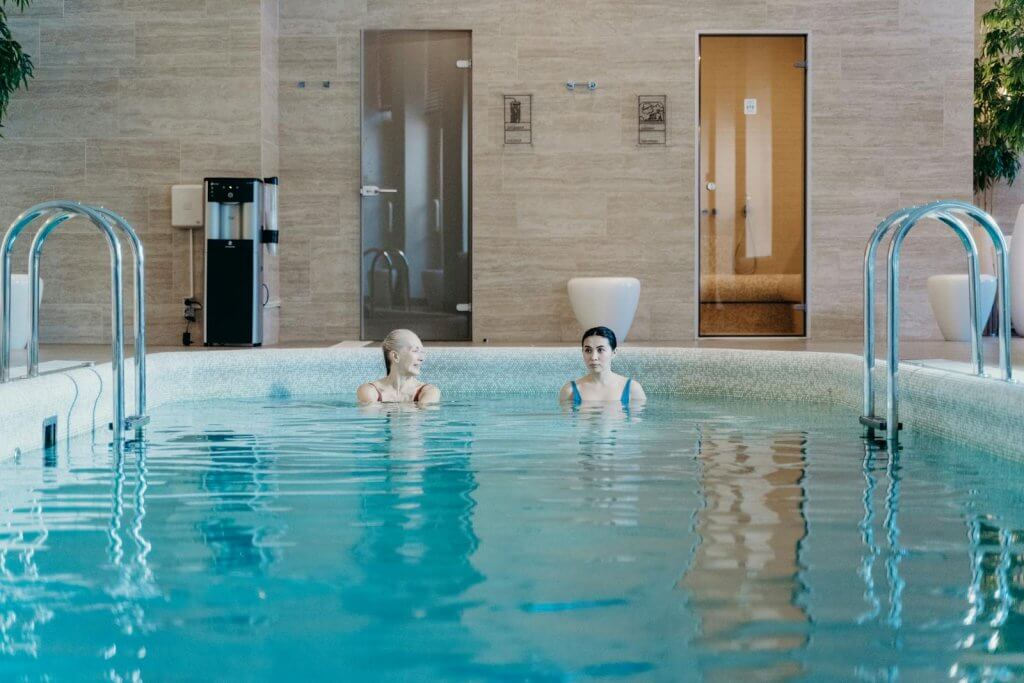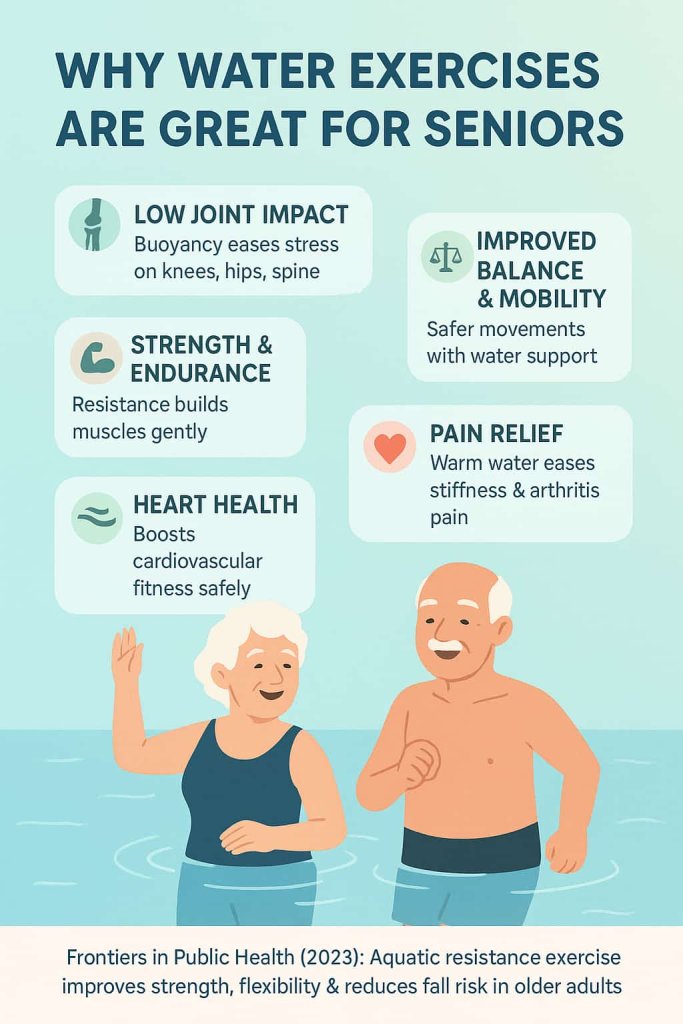Yes — water exercises are one of the best ways for seniors to stay strong, mobile, and pain-free. The buoyancy of water takes pressure off the joints while providing natural resistance that builds strength and endurance.

For older adults, staying active is key to independence, balance, and overall health. Water workouts are safe, low-impact, and enjoyable, making them perfect for those with arthritis, back pain, or limited mobility. With just a few weekly sessions, seniors can improve flexibility, muscle tone, cardiovascular health, and reduce fall risk.
In this guide, you’ll learn the 12 best water exercises for seniors, their benefits, step-by-step instructions, and safety tips to get started.
👉 According to the Mayo Clinic, aquatic exercise improves flexibility, strength, and aerobic fitness while reducing stress on the body’s joints.
Why Water Exercises Are Great for Seniors

- Low joint impact – Buoyancy eases stress on knees, hips, and spine.
- Improved balance & mobility – Water supports movement, lowering fall risk.
- Strength & endurance – Resistance builds muscles without heavy weights.
- Pain relief – Warm water reduces stiffness from arthritis and chronic pain.
- Heart health – Water workouts provide safe aerobic training.
👉 A 2023 review in Frontiers in Public Health found aquatic resistance exercise significantly improved lower limb strength, flexibility, agility, and reduced fall risk in older adults.
12 Best Water Exercises for Seniors
Water supports the body, reducing joint strain, while providing natural resistance to build strength. Below are 12 of the best water exercises for older adults, with instructions, benefits, and safety tips.
1. Water Walking
How to do it:
- Enter waist- or chest-deep water.
- Walk forward across the pool, swinging your arms naturally.
- Try backward walking as well for added challenge.
Benefits: Improves cardiovascular fitness, strengthens legs, and boosts stability.
Trainer Tip: Keep your chest up and take longer strides to engage your core.
2. Marching in Place
How to do it:
- Stand tall in chest-deep water.
- Lift one knee toward your chest, then lower and switch sides.
- Continue alternating for 30–60 seconds.
Benefits: Builds hip strength, warms up muscles, and improves coordination.
Trainer Tip: Hold the pool rail for extra balance if needed.
3. Calf Raises
How to do it:
- Stand near the pool wall for support.
- Rise onto your toes, lifting heels as high as possible.
- Hold briefly, then lower back down. Repeat 10–15 times.
Benefits: Strengthens calves, ankles, and improves walking stability.
Trainer Tip: Try single-leg calf raises for added challenge.
4. Arm Curls (With or Without Water Weights)
How to do it:
- Hold water dumbbells or make fists.
- Start with arms down at your sides.
- Bend elbows to curl hands toward shoulders, then lower slowly.
Benefits: Strengthens biceps and forearms, making daily lifting easier.
Trainer Tip: Move slowly against the water for maximum resistance.
5. Chest Fly / Lateral Arm Raises
How to do it:
- Stand with arms out to the sides, submerged at shoulder level.
- Bring arms together in front of your chest, then return to the sides.
- Perform 10–12 reps.
Benefits: Strengthens chest, shoulders, and improves posture.
Trainer Tip: Keep elbows slightly bent to protect joints.
6. Leg Kicks (Front, Side, Back)
How to do it:
- Hold onto the pool wall or a kickboard.
- Gently kick one leg forward, then sideways, then backward.
- Alternate legs for 10–12 kicks each direction.
Benefits: Strengthens quads, hamstrings, and hips while boosting flexibility.
Trainer Tip: Start small and increase your range of motion gradually.
7. Hip Abductions
How to do it:
- Stand tall and hold the pool rail for balance.
- Lift one leg out to the side, pause, then return.
- Switch legs and repeat 8–12 times per side.
Benefits: Strengthens outer thighs, improves hip stability, and supports walking balance.
Trainer Tip: Keep torso upright—don’t lean sideways.
8. Flutter Kicks / Bicycle Legs
How to do it:
- Hold onto the pool wall or float on a noodle.
- Kick legs alternately in flutter motion, or pedal in bicycle style.
- Continue for 30–60 seconds.
Benefits: Improves endurance, core strength, and hip mobility.
Trainer Tip: Engage your core to avoid straining your lower back.
9. Walking Lunges
How to do it:
- In shallow water, step forward with one leg.
- Bend both knees to about 90 degrees.
- Push through your heel to step forward with the other leg.
- Repeat across the pool.
Benefits: Strengthens glutes, quads, and enhances balance.
Trainer Tip: Take long but controlled steps—avoid rushing.
10. Core Twists
How to do it:
- Stand with feet hip-width apart in chest-deep water.
- Extend arms forward.
- Twist upper body slowly side to side while keeping hips steady.
Benefits: Strengthens obliques, improves rotation, and builds core stability.
Trainer Tip: Move gently—avoid jerking motions.
11. Aqua Jump Squats
How to do it:
- Stand with feet shoulder-width apart.
- Bend knees slightly, then push off the pool floor into a gentle jump.
- Land softly with knees bent. Repeat 8–10 times.
Benefits: Builds leg power, improves cardio fitness, and reduces joint strain.
Trainer Tip: Keep movements small—focus on control, not height.
12. Single-Leg Balance
How to do it:
- Stand on one leg in waist-deep water.
- Hold for 15–30 seconds, then switch legs.
- Repeat 2–3 times per side.
Benefits: Improves balance, coordination, and ankle stability.
Trainer Tip: Use the pool rail for support until you feel confident.
Who Should Avoid Water Exercises?
Water workouts are safe for most seniors, but there are cases where medical clearance is essential:
- Open wounds or skin infections – Pools can worsen infections or spread germs.
- Uncontrolled epilepsy or seizure disorders – Increases risk of drowning without supervision.
- Severe heart or lung conditions – Water pressure may make breathing or circulation harder.
- Unhealed surgical incisions – Wait until fully healed before entering the pool.
- Severe fear of water or poor balance – Consider aquatic therapy or supervised sessions.
- Active contagious illness – Stay out of pools until fully recovered.
👉 Always consult your doctor or physical therapist before beginning any aquatic exercise program.
Tips to Get Started Safely
- Begin with 10–15 minutes, increase gradually.
- Use water shoes for grip and joint support.
- Stay in waist- to chest-deep water for stability.
- Drink water — you can still dehydrate while exercising in the pool.
- Consult your doctor before starting if you have arthritis, heart conditions, or balance issues.
👉 The Arthritis Foundation highlights that aquatic exercise helps reduce joint pain and stiffness in people with arthritis.
How Often Should Seniors Do Water Exercises?
Experts recommend 2–3 times per week, but even short 15–20 minute sessions can improve flexibility, strength, and reduce pain. Many seniors enjoy joining aqua fitness classes for motivation and social support.
FAQ
1. Is water exercise safe for seniors with arthritis?
Yes. Water supports the joints, reduces stiffness, and makes movement easier for arthritis patients.
2. Do I need swimming skills for water exercises?
No. Most exercises are done in waist- or chest-deep water with feet on the pool floor.
3. Can water workouts replace gym workouts?
They can for many seniors, as they combine cardio, strength, and flexibility in one session.
4. What equipment is useful for water exercises?
Water dumbbells, noodles, kickboards, and resistance gloves add variety and resistance.
5. How long should each session last?
Start with 15–20 minutes, progress to 30–45 minutes as endurance improves.
6. Is warm water better for seniors?
Yes. Pools heated to 82–90°F (28–32°C) are most comfortable for older adults.
7. Can water exercises help prevent falls?
Yes. Water workouts improve leg strength, balance, and coordination, which lowers fall risk.
Conclusion
Water exercises are one of the safest and most effective ways for seniors to stay strong, flexible, and pain-free. Whether you’re managing arthritis, recovering from injury, or just looking for a fun way to stay active, aquatic workouts offer low-impact strength, cardio, and balance training.
✅ Start small, stay consistent, and enjoy the benefits of moving in water.
